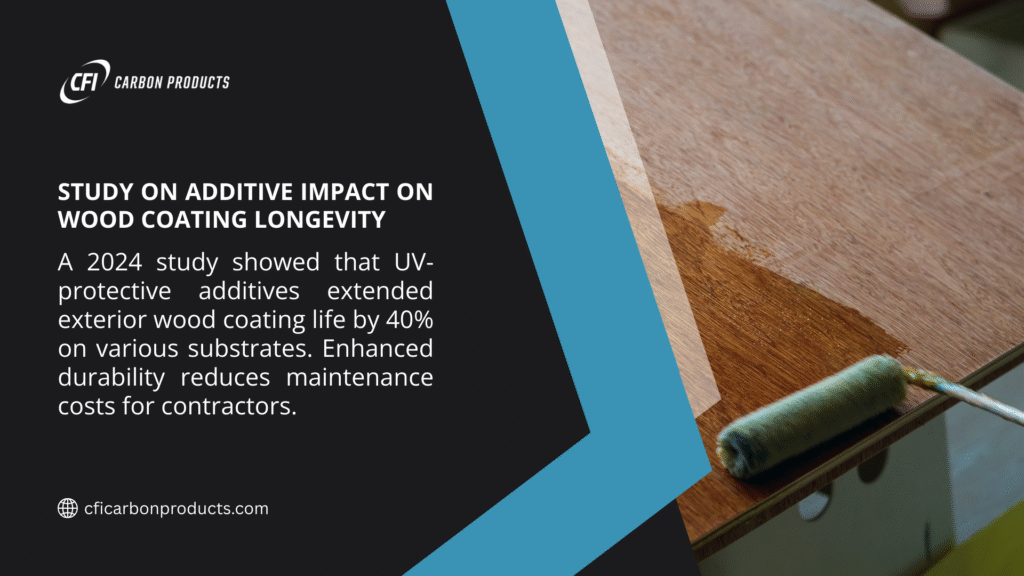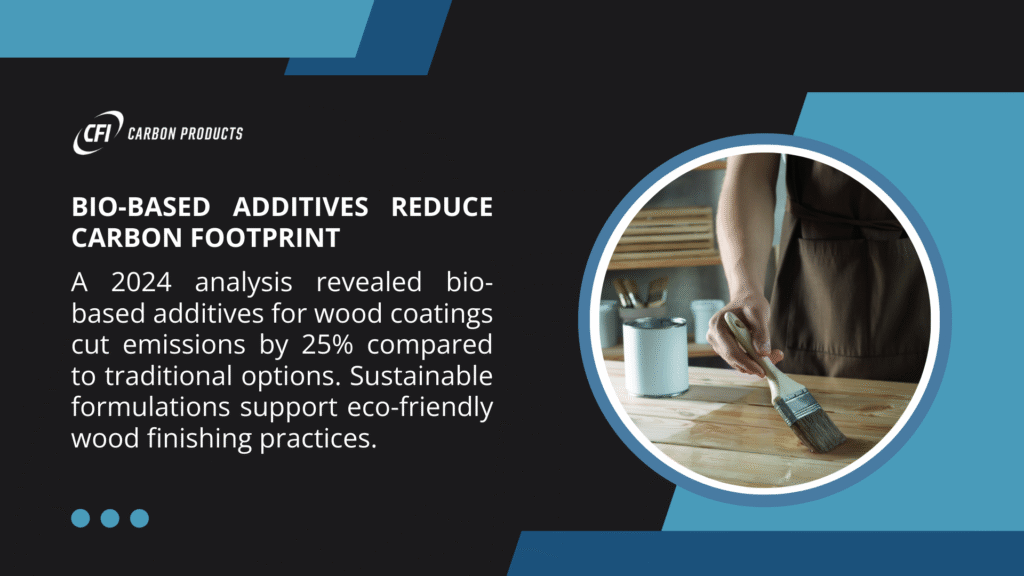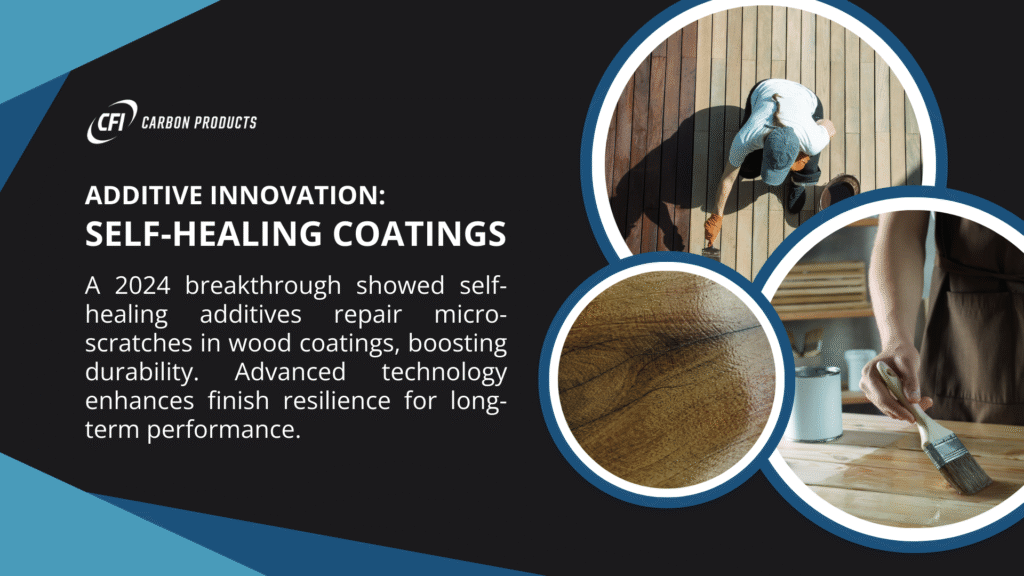Article Summary
- Why additives for wood coatings matter in professional finishing
- Common wood coating problems and how additives solve them
- Specific additive types for different wood species and applications
- Real-world selection criteria for contractors and manufacturers
- Austin Black 325 benefits in wood coating formulations
- Cost analysis and ROI considerations for premium additives
Introduction
Wood finishing professionals know that standard coatings alone rarely deliver the performance clients expect. Additives for wood coatings bridge this gap by solving specific problems that plague wooden substrates. From preventing tannin bleed-through to extending exterior durability, these specialized compounds make the difference between mediocre results and exceptional finishes.
The market demands coatings that look great and last longer. Builders, contractors, and furniture manufacturers face increasing pressure to deliver projects that maintain their appearance for years, not months. Smart professionals have discovered that the right additives for wood coatings often cost less than callbacks and warranty work.
Wood presents challenges that metal or concrete don’t. It moves with humidity changes, bleeds natural extractives, and degrades under UV exposure. Generic coating additives simply can’t address these wood-specific issues effectively.
Why Wood Needs Special Additives
Wood substrates create headaches that other materials don’t. The cellular structure of wood absorbs and releases moisture, causing dimensional changes that stress coating films. Natural extractives like tannins migrate through coating layers, creating stains and discoloration that ruin expensive finishes.
Smart contractors recognize these challenges early and plan accordingly. They select additives for wood coatings based on the specific wood species, environmental exposure, and performance expectations for each project.
Most coating failures on wood trace back to substrate-related issues that proper additives could have prevented. The cost of prevention through quality additives typically runs far less than the expense of stripping and refinishing failed projects.

Common Wood Coating Challenges
Professional applicators encounter predictable problems when coating wood substrates. Each challenge requires specific additive solutions to achieve reliable results.
| Problem Type | What Causes It | Visual Signs | Business Impact |
| Tannin Bleeding | Water-soluble extractives migrate upward | Brown stains, streaking, color shifts | Customer complaints, warranty claims |
| Grain Raising | Moisture swells wood fibers | Rough texture, poor appearance | Rework requirements, material waste |
| Poor Adhesion | Contaminated or difficult surfaces | Peeling, flaking, delamination | Complete refinish needed, relationship damage |
| Uneven Color | Varying wood porosity and grain | Blotchy appearance, streaking | Aesthetic failure, project rejection |
| Premature Failure | UV damage, moisture cycling | Chalking, cracking, color loss | Maintenance costs, reputation damage |
Each of these problems costs money and damages reputations. Experienced professionals invest in quality additives for wood coatings to avoid these expensive failures.
Essential Additive Types for Wood Applications
Different additives for wood coatings serve specific functions in creating successful coating systems. Understanding what each type accomplishes helps professionals select the right combination for their projects.
Sealers and Primers
Base coat additives control how the wood interacts with subsequent coating layers. These materials address porosity variations and contamination issues that cause finish problems.
| Sealer Type | Primary Function | Best Applications | Performance Benefits |
| Penetrating Sealers | Deep fiber saturation | Open-grain hardwoods, end grain | Prevents grain raising, equalizes absorption |
| Barrier Primers | Block extractive migration | Redwood, cedar, pine | Prevents tannin bleeding, color stability |
| Equalizing Coats | Uniform surface preparation | Mixed wood species | Consistent appearance, predictable results |
Professionals who skip proper sealing often regret it later. The carbon black for coatings in pigmented primers provides both hiding power and UV protection in a single component.
Flow and Leveling Agents
Application quality depends heavily on how coatings behave during and after application. Flow additives determine whether you get a smooth, professional finish or visible brush marks and application defects.
| Application Method | Critical Flow Properties | Recommended Additives | Quality Impact |
| Brush Application | Extended open time, brush drag reduction | Leveling agents, open time extenders | Smooth finish, reduced labor time |
| Spray Application | Proper atomization, reduced orange peel | Rheology modifiers, anti-cratering agents | Uniform appearance, high transfer efficiency |
| Roller Application | Anti-spattering, smooth laydown | Flow enhancers, anti-foam agents | Professional appearance, faster coverage |
Getting flow properties right eliminates most application-related defects. Poor flow wastes material and creates surfaces that require additional work to achieve acceptable quality.
UV Protection Additives
Exterior wood applications face constant attack from ultraviolet radiation. Without proper protection, even premium coatings fail within a few years through UV-induced degradation.
| UV Challenge | Damage Mechanism | Protection Strategy | Long-term Benefit |
| Polymer Breakdown | Chain scission, cross-linking | UV absorbers, antioxidants | Extended coating life, color retention |
| Wood Degradation | Lignin destruction, surface erosion | Light screening pigments | Substrate preservation, adhesion maintenance |
| Color Fading | Chromophore destruction | Photostable colorants | Appearance retention, reduced maintenance |
UV stabilizer additive technology has advanced significantly, but proper selection still requires matching the additive system to the specific exposure conditions.
Wood Species and Additive Selection
Different wood species create unique challenges that require tailored additive approaches. Successful professionals adjust their additive selection based on the specific characteristics of each wood type.
Softwood Challenges
Pine, fir, and other softwoods present specific coating challenges that generic additives often can’t address effectively.
| Softwood Issue | Root Cause | Additive Solution | Application Notes |
| Resin Bleeding | Pitch pockets, incomplete kiln drying | Resin sealers, blocking agents | Multiple light coats work better than single heavy application |
| Grain Pattern | Growth ring density variation | Equalizing sealers, grain fillers | End grain requires extra attention and sealing |
| Knot Bleeding | High resin concentration | Knot sealers, barrier coats | Spot treatment before full coating application |
Softwood projects often require extra preparation time, but proper additives for wood coatings can dramatically reduce callback risks on these challenging substrates.
Hardwood Applications
Dense hardwoods like oak, maple, and ash create different challenges that require specialized additive approaches.
| Hardwood Characteristic | Coating Challenge | Additive Approach | Success Factors |
| High Tannin Content | Staining, discoloration | Tannin blockers, chelating agents | Proper cure time between coats |
| Deep Grain Structure | Filling requirements, appearance | Grain fillers, leveling compounds | Multiple fill coats may be needed |
| Dense Surface | Poor penetration, adhesion | Wetting agents, adhesion promoters | Surface preparation becomes critical |
Professional cabinet shops rely heavily on quality additives for wood coatings to achieve the smooth, filled appearance that high-end furniture requires.
Exotic Wood Species
Imported woods like teak, mahogany, and ipe present unique challenges that require specialized knowledge and materials.
| Exotic Wood | Primary Challenge | Required Additives | Special Considerations |
| Teak | Natural oils, low surface energy | Wetting agents, oil-compatible systems | May require solvent washing before coating |
| Ipe | Extreme density, extractives | Penetrating primers, adhesion promoters | Limited coating options, specialized application |
| Mahogany | Interlocked grain, high tannin | Grain stabilizers, tannin blockers | Multiple sealer coats often required |
These premium woods justify the investment in specialized additives for wood coatings because the substrate cost makes coating failure extremely expensive.

Application Environment Considerations
The environment where coated wood will serve determines the additive requirements for long-term success. Interior and exterior applications need different additive packages to perform reliably.
Interior Applications
Indoor environments present fewer challenges but still require appropriate additive selection for optimal results.
| Interior Environment | Key Factors | Additive Priorities | Performance Goals |
| Residential | Appearance, durability, safety | Flow agents, low-odor systems | Beautiful finish, family-safe application |
| Commercial | Durability, maintenance, cost | Wear resistance, cleanability | Long service life, easy maintenance |
| Industrial | Chemical resistance, safety | Specialized protective systems | Regulatory compliance, worker protection |
Even interior applications benefit from quality additives for wood coatings, particularly in high-traffic or high-humidity environments like kitchens and bathrooms.
Exterior Exposures
Outdoor wood faces multiple environmental stresses that require comprehensive additive protection to achieve acceptable service life.
| Environmental Stress | Damage Mechanism | Protection Strategy | Critical Additives |
| UV Radiation | Polymer and wood degradation | Light screening, UV absorption | Carbon black, UV absorbers, antioxidants |
| Moisture Cycling | Dimensional stress, hydrolysis | Vapor barriers, flexible films | Water repellents, plasticizers, biocides |
| Temperature Extremes | Thermal stress, brittleness | Thermal stability, flexibility | Heat stabilizers, impact modifiers |
| Biological Attack | Mold, mildew, insects | Antimicrobial protection | Biocides, preservatives, pH adjusters |
Marine environments create the most demanding conditions. Salt air and constant humidity require premium additives for wood coatings to achieve reasonable service life.
Austin Black 325 in Wood Coating Applications
Austin Black 325 offers unique advantages for wood coating formulations, particularly where UV protection and color development are priorities. This specialized carbon black from CFI Carbon Products addresses multiple wood coating challenges simultaneously.
Technical Advantages
Austin Black 325 delivers several benefits that make it valuable in demanding wood coating applications.
| Property | Austin Black 325 Performance | Wood Coating Benefit | Economic Impact |
| UV Screening | Excellent light absorption | Extended coating life | Reduced maintenance costs |
| Particle Size | Fine, uniform dispersion | Smooth finish quality | Less material waste, better appearance |
| Tinting Strength | High color development efficiency | Consistent color matching | Reduced tinting costs, inventory simplification |
| Stability | Excellent storage properties | Extended product shelf life | Reduced waste, improved logistics |
The carbon black structure in Austin Black 325 provides optimal performance in wood coating applications without compromising other properties.
Wood-Specific Applications
Austin Black 325 proves particularly valuable in challenging wood coating scenarios where multiple benefits are needed.
| Application Type | Austin Black 325 Benefits | Performance Improvement | Cost Consideration |
| Exterior Stains | UV protection, color depth | Extended service life, appearance retention | Premium pricing justified by performance |
| Cabinet Finishes | Smooth application, consistent color | Professional appearance, reduced touch-up | Labor savings offset material costs |
| Architectural Coatings | Weather resistance, color stability | Reduced maintenance cycles | Lifecycle cost advantages |
| Marine Applications | Salt resistance, UV protection | Extended durability in harsh environments | Essential for warranty compliance |
For manufacturers seeking sustainable options, Austin Black 325 offers environmental advantages compared to conventional carbon black additives for wood coatings.
Cost Analysis for Premium Additives
Investment in quality additives for wood coatings typically pays for itself through improved performance and reduced failure rates. Smart professionals calculate total project costs rather than focusing solely on material expenses.
Direct Cost Factors
Understanding the true cost of additives requires looking beyond purchase price to total project impact.
| Cost Component | Premium Additive Impact | Budget Consideration | ROI Factors |
| Material Cost | 10-20% higher purchase price | Higher upfront investment | Better performance per dollar |
| Labor Efficiency | Improved application properties | Faster application, less rework | Reduced labor hours, better margins |
| Callback Prevention | Fewer warranty issues | Lower risk exposure | Reputation protection, customer retention |
| Service Life | Extended durability | Longer maintenance intervals | Reduced lifecycle costs |
Most professionals find that premium additives for wood coatings cost less than 5% of total project value while significantly reducing risk and improving results.
Value Calculation Methods
Smart contractors track the real value of additive investments through careful project analysis.
| Measurement Approach | Tracking Method | Key Metrics | Business Benefit |
| Callback Rates | Project follow-up, warranty claims | Percentage requiring rework | Direct cost avoidance |
| Customer Satisfaction | Follow-up surveys, repeat business | Satisfaction scores, referrals | Business growth, premium pricing |
| Application Efficiency | Time tracking, material usage | Labor hours per square foot | Improved profitability |
| Durability Performance | Long-term appearance monitoring | Service life extension | Competitive advantage |
Carbon black pricing analysis helps contractors understand the value proposition of premium additives versus standard alternatives.
Selection Guidelines for Professionals
Choosing appropriate additives for wood coatings requires systematic evaluation of project requirements, substrate characteristics, and performance expectations.
Project Assessment Framework
Successful additive selection starts with thorough project analysis that identifies critical success factors and potential failure modes.
| Assessment Area | Key Questions | Information Sources | Decision Impact |
| Substrate Analysis | Wood species, condition, preparation | Visual inspection, moisture testing | Additive type selection |
| Environmental Exposure | Indoor/outdoor, climate, pollution | Site evaluation, historical data | Protection level requirements |
| Performance Expectations | Appearance, durability, maintenance | Client discussions, specifications | Quality level determination |
| Application Constraints | Timeline, weather, equipment | Project schedule, resource availability | Additive compatibility needs |
This systematic approach prevents expensive mistakes and ensures that selected additives for wood coatings match actual project requirements.
Technical Evaluation Process
Once project requirements are clear, technical evaluation helps narrow additive choices to the most appropriate options.
| Evaluation Stage | Testing Methods | Success Criteria | Go/No-Go Decisions |
| Compatibility Testing | Small batch trials | No adverse reactions | Proceed to performance testing |
| Performance Validation | Standard test methods | Meet specification requirements | Approve for project use |
| Application Trials | Field testing conditions | Acceptable working properties | Finalize application procedures |
| Quality Confirmation | Final inspection, measurements | Meet appearance and performance standards | Project approval, documentation |
Professional applicators often work with suppliers like CFI Carbon Products to access technical support and testing services that validate additive performance before committing to large projects.

Quality Control and Monitoring
Consistent results with additives for wood coatings require systematic quality control procedures that catch problems early and maintain performance standards.
Incoming Material Inspection
Quality starts with verifying that additives meet specifications before they enter production or application processes.
| Inspection Area | Test Methods | Acceptance Criteria | Failure Response |
| Physical Properties | Viscosity, particle size, color | Within specification limits | Reject lot, investigate supplier |
| Chemical Composition | Analysis, titration, chromatography | Meet certificate of analysis | Return to supplier, find alternative |
| Storage Stability | Aging tests, shelf life validation | Maintain properties over time | Adjust inventory rotation, improve storage |
| Batch Consistency | Lot-to-lot comparison | Minimal variation between batches | Supplier discussion, process improvement |
Established quality procedures prevent expensive field failures and maintain customer confidence in delivered results.
Application Monitoring
Field quality control ensures that additives for wood coatings perform as expected under actual application conditions.
| Monitoring Stage | Control Points | Measurement Methods | Corrective Actions |
| Mixing Procedures | Ratio accuracy, dispersion quality | Visual inspection, testing | Retrain operators, improve procedures |
| Application Conditions | Temperature, humidity, contamination | Environmental monitoring | Adjust timing, improve controls |
| Film Formation | Appearance, thickness, uniformity | Visual and instrumental measurement | Immediate correction, documentation |
| Early Performance | Adhesion, appearance, defects | Standard test procedures | Process adjustment, material changes |
Professional contractors maintain detailed records that help them optimize their use of additives for wood coatings over time.
Troubleshooting Common Problems
Even with careful planning, wood coating projects sometimes encounter problems that require quick diagnosis and effective solutions.
Appearance Defects
Visual problems often relate to additive selection or application issues that can be corrected with proper diagnosis.
| Defect Type | Probable Causes | Additive Solutions | Prevention Methods |
| Brush Marks | Poor leveling, fast dry | Flow agents, open time extenders | Proper additive selection, technique training |
| Orange Peel | Spray application issues | Rheology modifiers, surface agents | Equipment adjustment, material changes |
| Color Streaking | Uneven substrate preparation | Equalizing sealers, tinting aids | Better substrate prep, consistent mixing |
| Surface Contamination | Foreign material, poor cleaning | Wetting agents, cleaning aids | Improved surface preparation |
Quick problem identification saves time and materials while maintaining project schedules and customer satisfaction.
Adhesion Failures
Poor adhesion represents one of the most serious coating failures and often requires complete refinishing to correct.
| Failure Mode | Root Causes | Corrective Additives | Long-term Solutions |
| Complete Delamination | Surface contamination, wrong primer | Adhesion promoters, cleaning agents | Better surface preparation procedures |
| Edge Lifting | Moisture infiltration | Vapor barriers, edge sealers | Improved application techniques |
| Spot Failures | Localized contamination | Spot primers, wetting agents | Enhanced inspection procedures |
| Coating Brittleness | Wrong additive selection | Plasticizers, flexible resins | Material selection review |
Understanding these failure modes helps professionals select appropriate additives for wood coatings that prevent expensive problems.
Innovation and Future Trends
The wood coating industry continues advancing through new additive technologies that address emerging market needs while maintaining environmental responsibility.
Emerging Technologies
Several technology trends are reshaping how additives for wood coatings address traditional challenges while enabling new capabilities.
| Technology Area | Current Developments | Market Drivers | Expected Benefits |
| Nanotechnology | Nanoparticle reinforcement | Superior performance demands | Improved scratch resistance, self-cleaning surfaces |
| Bio-based Chemistry | Renewable raw materials | Environmental regulations | Sustainable production, reduced environmental impact |
| Smart Materials | Responsive coating systems | Value-added functionality | Self-healing properties, adaptive performance |
| Digital Integration | Precision application control | Quality consistency demands | Reduced waste, improved repeatability |
These innovations will expand the capabilities of additives for wood coatings while addressing environmental concerns and market demands for enhanced performance.
Sustainability Focus
Environmental considerations increasingly drive additive development and selection decisions across the wood coating industry.
| Sustainability Factor | Industry Response | Technology Solutions | Market Impact |
| VOC Reduction | Water-based systems | Alternative solvents, reactive thinners | Regulatory compliance, healthier workplaces |
| Renewable Content | Bio-based additives | Plant-derived raw materials | Marketing advantages, reduced carbon footprint |
| Recyclability | Compatible formulations | Separable coating systems | End-of-life management, circular economy |
| Energy Efficiency | Low-temperature curing | UV-curable systems, ambient cure | Reduced energy costs, faster production |
CFI Carbon Products demonstrates commitment to sustainability through environmentally responsible production methods for additives for wood coatings.
Partner with CFI Carbon Products
CFI Carbon Products brings decades of experience in developing and manufacturing additives for wood coatings that solve real-world application challenges. Their Austin Black 325 product line offers unique advantages for demanding wood coating applications.
The company’s technical team understands the specific challenges that wood substrates present and can recommend appropriate additive solutions for different application scenarios. From furniture finishing to architectural coatings, CFI’s expertise helps professionals achieve consistent, high-quality results.
Explore Austin Black 325 to discover how this innovative additive can improve your wood coating results while supporting sustainability goals. CFI’s commitment to quality and customer service ensures reliable supply and technical support when you need it.
For comprehensive wood coating solutions, CFI’s services include formulation support, compatibility testing, and application guidance that help professionals optimize their use of additives for wood coatings.
Key Takeaways
- Additives for wood coatings solve substrate-specific problems that generic additives cannot address
- Proper selection requires understanding wood species characteristics, application environment, and performance requirements
- Austin Black 325 provides UV protection, color development, and environmental benefits in wood coating applications
- Quality control and systematic testing ensure consistent performance and prevent expensive failures
- Investment in premium additives typically pays for itself through improved performance and reduced callbacks
- Future trends point toward sustainable, high-performance additives that address environmental and regulatory requirements
Final Thoughts
Success with additives for wood coatings comes from understanding the unique challenges that wooden substrates present and selecting materials that address these specific requirements effectively. The combination of proper material selection, quality application techniques, and systematic quality control creates coating systems that deliver exceptional performance and customer satisfaction.
Professional contractors and manufacturers who invest in quality additives for wood coatings often discover that the improved results and reduced failure rates more than justify the additional material costs. This approach supports both immediate project success and long-term business growth through satisfied customers and positive reputation.For detailed information about wood coating solutions and technical support, visit CFI Carbon Products’ resources or contact their specialists to discuss your specific application requirements. Their expertise in coating additives can help identify optimal solutions for challenging wood coating applications.
Also read:

